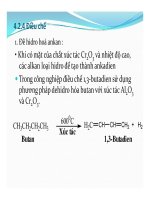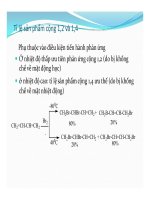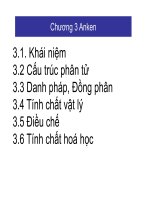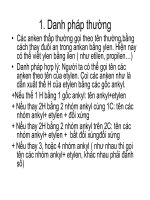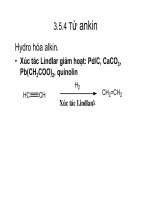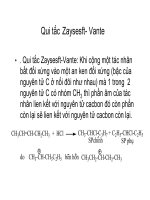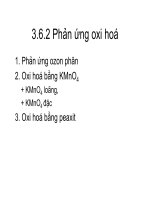Bài giảng hóa học đại cương i
Bạn đang xem bản rút gọn của tài liệu. Xem và tải ngay bản đầy đủ của tài liệu tại đây (12.14 MB, 58 trang )
THUY LOI UNIVERSITY
Lecture Notes
GENERAL CHEMISTRY 2
(The contents of the lectures may be changed without notice)
HÀ NỘI, 01 - 2016
24-Feb-16
Chapter 16
Chemistry
Kinetics: Rates and Mechanisms
The Molecular Nature of
Matter and Change
24-Feb-16
of Chemical Reactions
24-Feb-16
1
2
Kinetics: Rates and Mechanisms of Chemical Reactions
16.1 Factors That Influence Reaction Rate
16.2 Expressing the Reaction Rate
16.1
16.3 The Rate Law and Its Components
16.4 Integrated Rate Laws: Concentration Changes over Time
Factors That Influence Reaction Rate
16.5 The Effect of Temperature on Reaction Rate
16.6 Explaining the Effects of Concentration and Temperature
16.7 Reaction Mechanisms: Steps in the Overall Reaction
16.8 Catalysis: Speeding Up a Chemical Reaction
24-Feb-16
3
24-Feb-16
4
24-Feb-16
6
1. Reactant Concentration: C ↑→ reaction rate ↑
2. Physical State: the greater the surface area per
unit volume, the more contact it makes with other
reactants, and the faster the reaction.
3. Temperature: T ↑→ reaction rate ↑
24-Feb-16
5
1
24-Feb-16
Reaction:
aA + bB → cC + dD
v (mol L-1 s-1); C (mol/L); t (s)
16.3
where a, b, c, and d are the coefficients for the balanced equation
The Rate Law & Reaction Orders
Example 1:
H2 + I2 → 2HI
24-Feb-16
24-Feb-16
7
Example 2:
For any general reaction
aA
+
8
bB → cC
+
NO(g) + O3(g) → NO2(g) + O2(g)
dD
vrxn = k[NO][O3]
The rate law:
→ the reaction order with respect to NO is 1.
vrxn = k[A]m.[B]n
→ the reaction order with respect to O3 is 1.
→ the reaction is second order overall.
• The term k is the rate constant, which is specific for a
---------------------------------------------------------------------
given reaction at a given temperature.
2NO(g) + 2H2(g)
• The exponents m and n are individual reaction orders
vrxn =
and are determined by experiment.
→
N2(g) + 2H2O(g)
k[NO]2[H2]1
→ the reaction is second order with respect to NO.
• m, n are also called to be reaction orders with respect to
→ the reaction is first order with respect to H2.
A, B.
•24-Feb-16(m+n) is called to be overall reaction order.
→ the reaction is third order overall.
9
24-Feb-16
10
How to determine
Exercise 1
Reaction Orders from experiments
Determine the individual order with respect to each reactant
and the overall reaction order from the given rate law.
To determine the values of m and n,
(a)2NO(g) + O2(g) → 2NO2(g);
• we run a series of experiments in which one
rate = k[NO]2[O2]
reactant concentration changes while the other
(b)CH3CHO(g) → CH4(g) + CO(g);
is kept constant,
rate = k[CH3CHO]3/2
• and we measure the effect on the initial rate in
(b)H2O2(aq) + 3I-(aq) + 2H+(aq) → I3-(aq) + 2H2O(l);
rate =
24-Feb-16
k[H2O2][I-]
each case.
24-Feb-16
11
2
12
24-Feb-16
Example 3: Determine the individual order with respect to each
Exercise 2
reactant and the overall reaction order from the given table
Determine the individual order with respect to each reactant
below:
and the overall reaction order from the given table below:
aA + bB → products
O2(g) + 2NO(g) → 2NO2(g)
Experiment
Initial Rate
(mol/L·s)
Initial [A]
(mol/L)
Initial [B]
(mol/L)
1
1.75x10-3
2.50x10-2
3.00x10-2
2
3.50x10-3
5.00x10-2
3.00x10-2
Experiment
Initial Rate
(mol/L·s)
[O2]
[NO]
3
3.50x10-3
2.50x10-2
6.00x10-2
1
3.21x10-3
1.10x10-2
1.30x10-2
4
7.00x10-3
5.00x10-2
6.00x10-2
2
6.40x10-3
2.20x10-2
1.30x10-2
3
12.48x10-3
1.10x10-2
2.60x10-2
4
9.60x10-3
3.30x10-2
1.30x10-2
5
28.8x10-3
1.10x10-2
3.90x10-2
Solution:
Initial Reactant
Concentrations (mol/L)
vrxn = k[A]m.[B]n
From the data, we make 3 mathematical equations, solve the
24-Feb-16
Example 4:
equations → the value of k, m, n
13
24-Feb-16
aA + bB → products
SOLUTION: we count the number of particles as
concentrations.
(a) For reactant A (red): experiments 1 and 2 have the same
number of particles of B, but the number of particles of A
doubles. The rate doubles. Thus the order with respect to A
is 1.
For reactant B (blue): experiments 1 and 3 show that when
the number of particles of B doubles (while A remains
constant), the rate quadruples. The order with respect to B
is 2.
The overall order is 1 + 2 = 3.
(b) Rate = k[A][B]2.
(c) Between experiments 3 and 4, the number of particles of A
doubles while the number of particles of B does not
change. The rate should double,
so rate = 2 x 2.0x10-4 = 4.0x10-4mol/L·s
(a) What is the reaction order with respect to A (red), B (blue)?
The overall order?
(b) Write the rate law for the reaction.
(c) Predict the initial rate of experiment 4.
Expt #
Initial rate
(mol/L·s)
14
1
2
3
4
0.50x10-4
1.0x10-4
2.0x10-4
?
24-Feb-16
15
24-Feb-16
16
First-order rate equation:
Second-order rate equation:
16.4
Integrated Rate Laws
Zero-order rate equation:
24-Feb-16
17
24-Feb-16
3
18
24-Feb-16
Example 5:
Units of k
At 1000oC, cyclobutane (C4H8) decomposes in a first-order
The value of k is easily determined from
reaction, with the very high rate constant of 87 s-1, to two
experimental rate data.
molecules of ethylene (C2H4).
(a) If the initial C4H8 concentration is 2.00 M, what is the
The units of k depend on the overall reaction order.
concentration after 0.010 s?
Overall Reaction Order
Units of k (t in seconds)
0
mol/(L·s)
1
1/s
2
L/(mol·s)
3
L2/(mol2·s)
(b)What fraction of C4H8 has decomposed in this time?
SOLUTION:
24-Feb-16
19
24-Feb-16
Graphs of 0th, 1st, 2nd reaction order
Reaction
Integrated Rate Law
Order
Zero-order reaction
Linear form
Linear graph
0
[A]t= -kt + [A]o
y = ax + b
[A]t & time
1
ln[A]t= -kt + ln[A]o
y = ax + b
ln[A]t & time
2
1/[A]t= +kt + 1/[A]o
y = ax + b
1/[A]t & time
[A]t & time
24-Feb-16
21
20
First-order reaction
ln[A]t & time
Second-order reaction
1/[A]t & time
24-Feb-16
22
Example 6:
Reaction Half-life
Find the rate constant of the reaction, if substance A (green)
•
The half-life (t1/2) for a reaction is the time taken for the
decomposes to two other substances, B (blue) and C (yellow), in a first-
concentration of a reactant to drop to half its initial value.
•
First-order reaction, t1/2 does not depend on the initial conc.
•
Second-order reaction, t1/2 is inversely proportional to the
order gaseous reaction. The following scenes represent the reaction
mixture at the start of the reaction (at 0.0 s) and after 30.0 s.
initial concentration.
•
Zero-order reaction, t1/2 is directly proportional to the initial
concentration.
Zero-order
reaction
First-order
reaction
Second-order
reaction
SOLUTION:
24-Feb-16
23
24-Feb-16
4
→ find t1/2 →k
24
24-Feb-16
Exercise 3
Draw the molecular scenes of the reaction mixture at t = 60.0 s and
Overview about Reaction Rate
90.0 s, if substance A (green) decomposes to two other substances, B
(blue) and C (yellow), in a first-order gaseous reaction. The following
Zero Order
First Order
Second Order
Rate law
rate = k
rate = k[A]
rate = k[A]2
Units for k
mol/L·s
1/s
L/mol·s
Half-life
[A]o/2k
ln2/k
1/(k[A]o)
Integrated rate law
[A]t = -kt + [A]0
ln[A]t = -kt + ln[A]0
1/[A]t = kt +1/[A]0
Plot for straight line
[A]t vs. t
ln[A]t vs. t
1/[A]t vs. t
Slope, y intercept
-k, [A]0
-k, ln[A]0
k, 1/[A]0
scenes represent the reaction mixture at the start of the reaction (at 0.0
s) and after 30.0 s.
24-Feb-16
24-Feb-16
25
26
• Temperature has a dramatic effect on reaction rate. For many
reactions, an increase of 10°C will double or triple the rate.
Experimental data shows that k increases exponentially as T
increases.
16.5
• The Arrhenius equation:
Temperature and the Rate Constant
k = rate constant
A = frequency factor
Ea = activation energy
R = 8.314 J/mol.K
Higher T
larger k
increased rate
Smaller Ea
24-Feb-16
27
24-Feb-16
28
Activation Energy
• In order to be effective, collisions between particles must
exceed a certain energy threshold.
• When particles collide effectively, they reach an activated state.
The energy difference between the reactants and the activated
state is the activation energy (Ea) for the reaction.
• The lower the activation energy, the faster the reaction.
24-Feb-16
Ea
29
24-Feb-16
5
30
24-Feb-16
Exothermic reaction, ∆Hrxn < 0
∆Hrxn > 0
∆Hrxn < 0
∆Hrxn = Ea,for – Ea,rev
24-Feb-16
31
24-Feb-16
Endothermic reaction, ∆Hrxn > 0
32
Calculating Activation Energy
Ea can be calculated from the Arrhenius equation:
At two different temperatures
k = rate constant
Ea = activation energy
R = 8.314 J/mol.K
∆Hrxn = Ea,for – Ea,rev
24-Feb-16
33
24-Feb-16
34
Graphs of Activation Energy
Integrated Rate Laws
Linear form
Linear graph
y = ax + b
lnk & 1/T
16.6
Effects of Concentration &
Temperature
24-Feb-16
24-Feb-16
35
6
36
24-Feb-16
Temperature and Collision Energy
Collision Theory
•
The basic principle of collision theory is that particles
•
An increase in temperature causes an increase in the
must collide in order to react.
kinetic energy of the particles. This leads to more frequent
•
collisions and reaction rate increases.
An increase in the concentration of a reactant leads to a
larger number of collisions, hence increasing reaction rate.
•
•
sufficient energy equal to or greater than Ea increases.
The number of collisions depends on the product of the
numbers of reactant particles, not their sum.
•
At a higher temperature, the fraction of collisions with
Reaction rate therefore increases.
Concentrations are multiplied in the rate law, not added.
24-Feb-16
37
24-Feb-16
38
Example 7:
Transition State Theory
Find Ea if the decomposition of hydrogen iodide,
•
2HI(g) → H2(g) + I2(g)
An effective collision between particles leads to the
formation of a transition state or activated complex.
has rate constants of 9.51x10-9 L/mol·s at 500 K, and 1.10x10-5
•
L/mol·s at 600 K.
partial bonds. It is a transitional species partway between
SOLUTION:
reactants and products.
•
The transition state is an unstable species that contains
Transition states cannot be isolated, and exists at the point
of maximum potential energy.
•
The energy required to form the transition state is the
activation energy.
24-Feb-16
39
24-Feb-16
40
Transition State & Intermediate State
•
An intermediate is a short-lived unstable molecule in a
reaction which is formed between the reaction when reactants
change into products..
•
Whereas, transition state is just the state before formation of
new molecule(involves breaking of bonds of reactants and
formation of new ones).
•
An intermediate differs from a transition state in that the
intermediate has a discrete lifetime (be it a few nanoseconds or
many days), whereas a transition state lasts for just one bond
vibration cycle.
24-Feb-16
24-Feb-16
41
7
42
24-Feb-16
•Transition states are local energy maximums and have partial
bonds. This might be one of the reasons why they can’t be
isolated as intermediates.
16.7
Reaction Mechanisms
24-Feb-16
24-Feb-16
43
44
Reaction Mechanisms
•
Rate Laws for General Elementary Steps
The mechanism of a reaction is the sequence of single
reaction steps that make up the overall equation.
•
Elementary Step
The individual steps of the reaction mechanism are called
Molecularity
Rate Law
elementary steps because each one describes a single
A → product
Unimolecular
Rate = k[A]
molecular event.
2A → product
Bimolecular
Rate = k[A]2
•
A + B → product
Bimolecular
Rate = k[A][B]
2A+B → product
Termolecular
Rate = k[A]2[B]
Each elementary step is characterized by its molecularity,
the number of particles involved in the reaction.
•
The rate law for an elementary step can be deduced from the
The molecularity of each step equals the total number
of reactant particles.
reaction stoichiometry – reaction order equals molecularity for
an elementary step only.
24-Feb-16
45
24-Feb-16
46
Example 8:
The following elementary steps are proposed for a reaction mechanism:
The Rate-Determining Step of a Reaction
(1) NO2Cl(g) → NO2(g) + Cl(g)
(2) NO2Cl(g) + Cl(g) → NO2(g) + Cl2(g)
•
(a) Write the overall balanced equation.
The slowest step in a reaction is the rate-determining or rate-
limiting step.
(b) Determine the molecularity of each step.
•
(c) Write the rate law for each step.
SOLUTION:
The rate law for the rate-determining step becomes the rate
law for the overall reaction.
a) Make the sum of the elementary steps to find the overall equation.
Example 9: the reaction NO2(g) + CO(g) → NO(g) + CO2(g) has
2NO2Cl(g) → 2NO2(g) + Cl2(g)
been proposed to occur by a two-step mechanism:
b) The molecularity of each step equals the total number of reactant particles.
Step(1) is unimolecular. Step(2) is bimolecular.
c) We write the rate law for each step using the molecularities as reaction
orders.
(1) NO2(g) + NO2(g) → NO3(g) + NO(g)
[slow; rate-determining]
(2) NO2(g) + CO(g) → NO2(g) + CO2(g)
[fast]
Overall rate law = slow rate law → vrxn = k[NO2]2
ratestep1 = k1[NO2Cl]
ratestep2 = k2[NO2Cl][Cl]
24-Feb-16
47
24-Feb-16
8
48
24-Feb-16
Catalysis
•
A catalyst is a substance that increases the reaction rate
without itself being consumed in the reaction.
16.8
•
In general, a catalyst provides an alternative reaction
pathway that has a lower total activation energy than the
Catalysis: Speeding up a Reaction
uncatalyzed reaction.
•
A catalyst will speed up both the forward and the reverse
reactions, and does not affect either ∆H or the overall yield for a
reaction.
24-Feb-16
49
24-Feb-16
50
Catalysis
•
Based on whether the catalyst occurs in the same phase as
the reactant and product, chemists recognize two categories of
catalyst:
+ homogeneous: the catalysis is same physical state as the
reactants and products
+ heterogeneous: the catalysis is NOT same physical state
Reaction energy diagram for a catalyzed (green) and uncatalyzed (red) process.
24-Feb-16
51
24-Feb-16
9
52
24-Feb-16
Chapter 17
Chemistry
Equilibrium: The Extent of
The Molecular Nature of
Matter and Change
Chemical Reactions
24-Feb-16
1
24-Feb-16
2
Equilibrium: The Extent of Chemical Reactions
17.1 The Equilibrium State and the Equilibrium Constant (K)
17.1
17.2 The Reaction Quotient (Q) and the Equilibrium Constant (K)
The Equilibrium State
17.3 Expressing Equilibria with Pressure Terms: Kc and Kp
& Equilibrium Constant (K)
17.4 Reaction Direction: Comparing Q and K
17.5 How to Solve Equilibrium Problems
17.6 Le Chatelier’s Principle
24-Feb-16
3
24-Feb-16
4
If rateforward = ratereverse
o In the previous chapter: Kinetics addresses the speed of
a reaction, the change in product concentration (or
reactant concentration) per unit time.
→ kforward[reactants]m = kreverse[products]n
o In this chapter: Equilibrium addresses the extent of a
reaction, the concentration of product that results given
unlimited reaction time.
• At equilibrium state:
rateforward = ratereverse
Keq is called the Equilibrium Constant
• A system at equilibrium is dynamic on the molecular
level; no further net change in reactant and product
concentrations is observed because changes in one
direction are balanced by changes in the opposite
direction.
24-Feb-16
• This expression is also known as the Law of Mass Action.
• The exponents (m and n) are equal to the coefficients in
the balanced chemical equation.
5
24-Feb-16
10
6
24-Feb-16
Example 1:
What is the K expression for?
N2O4(g) ⇌ 2NO2(g). What is the K expression?
a)
17.2
The Reaction Quotient (Q) and the
A-(aq)
b)
+ H2O(l) ⇌ HA(aq) +
OH-(aq)
24-Feb-16
Equilibrium Constant (K)
7
For a general reaction:
24-Feb-16
aA + bB ⇌ cC + dD
8
Rules calculating with K
•At the equilibrium state:
For a general reaction:
•Original reaction: aA + bB ⇌ cC + dD
•At any time state:
•Reverse reaction: cC + dD ⇌ aA + bB
•Multiply with n: naA + nbB ⇌ ncC + ndD
Q is called the Reaction Quotient
Relationship Q & K
Reaction Direction
Q
Go right, product-favored
Q=K
At equilibrium
Q>K
Go left, reactant-favored
24-Feb-16
•Overall reaction that is equal the sum of many reaction:
• Pure solids and liquids are not included in the equilibrium
constant expression.
9
24-Feb-16
Example 2:
In the cylinders of a car engine, at the very high temperatures,
form nitrogen dioxide, a toxic pollutant that contributes to
photochemical smog.
N2(g) + O2(g) ⇌ 2NO(g)
Exercise 1
Write the reaction quotient, Qc, for each of the following
reactions:
a) The decomposition of dinitrogen pentoxide,
(1) K1 = 4.3 x 10-25
2NO(g) + O2(g) ⇌ 2NO2(g) (2) K2 = 6.4 x 109
a) Show the overall reaction.
b) Calculate the K for the overall reaction.
----------------------------------------------a)
N2(g) + O2(g) ⇌ 2NO(g)
(1)
+
2NO(g) + O2(g) ⇌ 2NO2(g) (2)
N2(g) + 2O2(g) ⇌ 2NO2(g)
b)
24-Feb-16
10
N2O5(g) ⇌ NO2(g) + O2(g)
b) The combustion of propane gas,
C3H8(g) + O2(g) ⇌ CO2(g) + H2O(g)
c) The calcium carbonate decomposes
CaCO3(s) ⇌ CaO(s) + CO2(g)
d) The acid dissociation reaction
CH3COOH(aq) + H2O(l) ⇌ CH3COO-(aq) + H3O+(aq)
11
24-Feb-16
11
12
24-Feb-16
For a general reaction: aA(g) + bB(g) ⇌ cC(g) + dD(g)
• At the equilibrium state, if the substances is gas:
17.3
Kc = concentration equilibrium constant.
Expressing Equilibria: Kc and Kp
Kp = pressure equilibrium constant.
• Relationship between Kc and Kp:
Kp = Kc.(RT)∆n
24-Feb-16
13
24-Feb-16
∆n = (c+d) – (a+b);
(R =0.082 at.L/mol.K)
14
Exercise 2
a) A chemical engineer injects limestone (CaCO3) into the hot
flue gas of a coal-burning power plant for form lime (CaO).
Find Kc for the following reaction, if CO2 pressure is in
atmospheres.
CaCO3(s) ⇌ CaO(s) + CO2(g)
Kp = 2.1x10-4 (at 1000 K)
b) Find Kp for the following reaction, if the gases pressure is in
atmospheres.
PCl3(g) + Cl2(g) ⇌ PCl5(g)
Kp = K c
Kc =1.67 (at 500 K)
.(RT)∆n
24-Feb-16
15
24-Feb-16
16
Reaction Progress
Reaction Progress
17.4
Reaction Direction: Q and K
Reactants Products
go right
24-Feb-16
17
24-Feb-16
12
Equilibrium:
no net change
Reactants Products
go left
18
24-Feb-16
Example 3:
Exercise 3:
The reaction of A(g) ⇌ B(g) at 175oC is composed of [A]= 2.8x10-4
M and [B] = 1.2x10-4 M at equilibrium state (A is red; B is blue).
The scenes below represent different mixtures of the reaction:
X(g) ⇌ Y(g) at 338 K with Kc = 1.4 (X is orange; Y is green).
Which direction does the reaction shift to in each of these
molecular scenes?
In which direction does the reaction shift (if at all) for each mixture
to reach equilibrium?
1)
2)
3)
4)
24-Feb-16
19
24-Feb-16
20
3 Forms of Equilibrium Exercises
1. Using Quantities to Determine the Equilibrium Constant
(Calculating K from Concentration Data).
2. Using the Equilibrium Constant to Determine Quantities
17.5
(Determining Equilibrium Concentrations from K).
How to Solve Equilibrium Problems
3. Mixtures of Reactants and Products: Determining Reaction
Direction (Predicting Reaction Direction and Calculating
Equilibrium Concentrations).
24-Feb-16
24-Feb-16
21
22
Example 4:
Steps to solve the equilibrium problems
In a study of hydrogen halide decomposition, a researcher fills an
evacuated 2.00 L flask with 0.200 mol of HI gas and allows the
reaction to proceed at 453 oC.
o Write the balanced equation.
2HI(g) ⇌ H2(g) + I2(g)
o Convert all of the amounts into the concentrations or
At equilibrium, [HI]eq = 0.078 M. Calculate Kc.
pressures.
----------------------------------------------Concentration (M)
2HI(g)
⇌
H2(g)
+ I2(g)
Initial
0.100
0
0
o Construct the ICE table.
o Solve for x.
Change
Equilibrium
o Find the equilibrium quantities or K.
24-Feb-16
23
24-Feb-16
13
(0.1-0.078)
0.078
0.011
0.011
24
24-Feb-16
Example 5:
Example 6:
In a study concerning the conversion of methane to other fuels,
a chemical engineer mixes gaseous CH4 and H2O in a 0.32-L
flask at 1200 K. At equilibrium the flask contains 0.26 mol of CO,
0.091 mol of H2, and 0.041 mol of CH4.
Fuel engineers use the extent of the change from CO and H2O to
CO2 and H2 to regulate the proportions of synthetic fuel mixtures.
If 0.250 mol of CO and 0.250 mol of H2O are placed in a 125-mL
flask at 900 K.
CH4(g) + H2O(g) ⇌ CO(g) + 3H2(g)
CO(g) + H2O(g) ⇌ CO2(g) + H2(g)
What is the [H2O] at equilibrium? Kc = 0.26 for the equation.
Conc. (M)
CH4(g)
+ H2O(g) ⇌ CO(g) + 3H2(g)
Initial
What is the composition of the equilibrium mixture? At this
temperature, Kc is 1.56 for the equation.
y
Equilibrium
24-Feb-16
25
⇌ CO2(g) + H2(g)
CO(g)
+ H2O(g)
Initial
Change
2.00
-x
2.00
-x
0
+x
0
+x
Equilibrium
(2-x)
(2-x)
x
x
Conc. (M)
Change
24-Feb-16
26
Example 7:
The research and development unit of a chemical company is
studying the reaction of CH4 and H2S, two components of natural
gas:
CH4(g) + 2H2S(g) ⇌ CS2(g)+ 4H2(g)
In one experiment, 1.00 mol of CH4, 1.00 mol of CS2, 2.00 mol of
H2S, and 2.00 mol of H2 are mixed in a 250-mL vessel at 960 oC.
At this temperature, Kc = 0.036.
17.6
Le Chatelier’s Principle
In which direction will the reaction proceed to reach equilibrium?
-----------------------------------------------
→ Qc > Kc → …
24-Feb-16
27
24-Feb-16
28
Example 8:
To improve air quality and obtain a useful product, chemists often
remove sulfur from coal and natural gas by treating the fuel
contaminant hydrogen sulfide with O2:
“When any system at equilibrium is subjected to change in
concentration, temperature, volume, or pressure, then the
system readjusts itself to (partially) counteract the effect of
2H2S(g) + O2(g) ⇌ 2S(s) + 2H2O(g)
∆H < 0
Which direction does the reaction shift to, if?
the applied change and a new equilibrium is established.”
a)O2 is added
The Effect of a Change in
b) H2S is removed
c) sulfur is added
-------------------------------------------+ When the equilibrium is established:
Concentration
Pressure
(Volume)
Temperature
a)If O2 is added → Qc < Kc → the equilibrium shift to the right.
b)If H2S is removed → Qc > Kc → the equilibrium shift to the left.
Reactant or
Products?
24-Feb-16
∆n < 0 or ∆n > 0
c)Sulfur is not part of the Q and K expression because it is a solid.
Therefore, as long as some sulfur is present the reaction is
unaffected
24-Feb-16
30
∆H < 0 or ∆H > 0
29
14
24-Feb-16
Example 9:
The Van’t Hoff Equation = the Effect of T on K
To improve air quality and obtain a useful product, chemists often
remove sulfur from coal and natural gas by treating the fuel
contaminant hydrogen sulfide with O2:
2H2S(g) + O2(g) ⇌ 2S(s) + 2H2O(g)
R = 8.314 J/mol*K
K = the equilibrium constant
∆H < 0
Van’t Hoff equation (Chapter 17)
∆Ho = 178 kJ
CaCO3(s) ⇌ CaO(s) + CO2(g)
----------------------------------------------------------------------------------
Which direction does the reactions equilibrium shift to, if?
a)increase in temperature
R = 8.314 J/mol*K
b) increase in pressure
k = the rate constant
--------------------------------------------
Arrhenius equation (Chapter 16)
a)With the case ∆H < 0, so if increase in temperature → decrease
K for a system → the equilibrium shift to the left.
-----------------------------------------------------------------------------------
The case ∆H > 0 → the equilibrium shift to the right.
R = 8.314 J/mol*K
a)With the case ∆n = -1 < 0, so if increase in pressure → the
equilibrium shift to the right.
The case ∆n = +1 > 0 → the equilibrium shift to the left.
24-Feb-16
P = the vapor pressure
Clausius-Clapeyron equation (Chapter 12)
31
24-Feb-16
Example 10:
32
Exercise 4
For the reaction: X(g) + Y2(g) ⇌ XY(g) + Y(g) H > 0
the following molecular scenes depict different reaction mixtures
(X = green, Y = purple).
The following reaction in equilibrium state with [PCl3] = 0.200 M, [Cl2] =
0.125M, [PCl5] = 0.600 M.
PCl3(g) + Cl2(g) ⇌ PCl5(g)
If we add 0.075 M of Cl2 to the above equilibrium mixture, what is the
composition of the new equilibrium mixture? At this temperature, Kc is
24 for the equation.
Concentration(M)
PCl3(g)
+ Cl2 (g)
Original equilibrium
0.200
0.125
Added
New Initial
Change
New Equilibrium
24-Feb-16
⇌
PCl5(g)
0.600
0.075
0.200
0.200
0.600
-x
-x
+x
(0.2-x)
(0.2-x)
(0.6+x)
(a) If K = 2 at the temperature of the reaction, which scene
represents the mixture at equilibrium?
(b) Will the reaction mixtures in the other two scenes proceed
toward reactant or toward products to reach equilibrium?
(c) For the mixture at equilibrium, how will a rise in temperature
affect [Y2]?
33
24-Feb-16
15
34
24-Feb-16
Lecture PowerPoint
Chapter 18
Chemistry
Acid-Base Equilibria
The Molecular Nature of
Matter and Change
Martin S. Silberberg
24-Feb-16
1
Copyright The McGraw-Hill Companies, Inc. Permission required for reproduction or display.
24-Feb-16
2
24-Feb-16
4
Acid-Base Equilibria
18.1 Acids and Bases in Water
18.2 Autoionization of Water and the pH Scale
18.3 Proton Transfer and the Brønsted-Lowry Acid-Base Definition
18.1
18.4 Solving Problems Involving Weak-Acid Equilibria
18.5 Weak Bases and Their Relation to Weak Acids
Acids and Bases in Water
18.6 Molecular Properties and Acid Strength
18.7 Acid-Base Properties of Salt Solutions
18.8 Generalizing the Brønsted-Lowry Concept: The Leveling Effect
18.9 Electron-Pair Donation and the Lewis Acid-Base Definition
24-Feb-16
3
Arrhenius Acid-Base Definition
The Acid Constant, Ka
• An acid is a substance that has H in its formula and
dissociates in water to yield
HA(aq) + H2O(l) ⇌ H3O+(aq) + A-(aq)
H3O+.
and
• A base is a substance that has OH in its formula and
dissociates in water to yield
OH-.
pKa = - log(Ka)
Ka = acid constant
• When an acid reacts with a base, they undergo
• The value of Ka is an indication of acid strength.
neutralization:
Stronger acid higher [H3O+] larger Ka
H+(aq) + OH-(aq) → H2O(l) ∆H°rxn = -55.9 kJ
Smaller Ka lower % dissociation of HA weaker acid
24-Feb-16
5
24-Feb-16
16
6
24-Feb-16
Perform the dissociations of
Strong and Weak Acids – Bases
The Base Constant, Kb
• A strong acid dissociates completely into ions in water:
B(aq) + H2O(l) ⇌ BH+(aq) + OH-(aq)
HA(l) + H2O(l) → H3O+(aq) + A-(aq)
and
pKb = - log(Kb)
• A weak acid dissociates slightly to form ions in water:
HA(aq) + H2O(l) ⇌ H3O+(aq) + A-(aq)
Kb = base constant
• Similarly for strong and weak bases.
• The value of Kb is an indication of base strength.
B(aq) + H2O(l) → BH+(aq) + OH-(aq)
Stronger base higher [OH-] larger Kb
B(aq) + H2O(l) ⇌ BH+(aq) + OH-(aq)
Smaller Kb weaker base.
24-Feb-16
7
24-Feb-16
8
Classifying of Weak Bases - Acids
Classifying of Strong Bases - Acids
• Weak acids include
The acid HF and acids in which H is not bonded to O or
to a halogen (HCN…)
Oxoacids in which the number of O atoms equals or
exceeds the number of ionizable H atoms by one (HClO,
HNO2…)
Carboxylic acids, which have the general formula
RCOOH (CH3COOH, C6H5COOH…)
• Weak bases include
Ammonia (NH3),
Amines, which have the formula RNH2, R2NH, R3N.
The common structural feature is an N atom with a lone
electron pair.
24-Feb-16
• Strong acids include
The hydrohalic acids (HCl, HBr, and HI).
Oxoacids in which the number of O atoms exceeds
the number of ionizable H atoms by two or more
(HNO3, H2SO4, HClO4…)
• Strong bases include
The cations are usually those of the most active
metals Group 1A metal & Group 2A metal: M2O or
MOH, where M = (Li, Na, K, Rb, Cs); MO or M(OH)2
where M = (Ca, Sr, Ba).
24-Feb-16
9
10
Exercise 1
Classify each of the following compounds as a strong acid,
18.2
weak acid, strong base, or weak base:
a) H2SeO4;
b) (CH3)2CHCOOH;
c) KOH;
Autoionization of Water,
d) (CH3)2CHNH2;
e) HClO;
f) HClO3;
pH scale
g) HCl;
h) CH3COOH;
i) NaOH;
24-Feb-16
11
24-Feb-16
17
12
24-Feb-16
The pH, pOH Scale
• Autoionization of water is a reaction that has form
2H2O(l) ⇌ H3O+(aq) + OH-(aq)
Kw = [H3O+][OH-] = 1.0x10-14
(at 25°C)
pKw = -logKw = 14
(at 25 oC)
pH = -log[H3O+]
&
pOH = -log[OH-]
The pH of a solution indicates its relative acidity:
In an acidic solution,
pH < 7.00
In a neutral solution,
pH = 7.00
In basic solution,
pH > 7.00
Kw = the constant for water
Kw = [H3O+][OH-] = 1.0x10-14
24-Feb-16
at 25°C
pKw = pH + pOH = 14.00 at 25°C
13
24-Feb-16
14
Example 1
Calculate [H3O+], pH, [OH-], pOH for the below solutions:
a) HNO3 2.5 M.
b) HNO2 2.5 M, Ka = 7.1×10-4.
---------------------------------------a)
HNO3 → H+ + NO3[H+] = 2.5 M
pH = -log[H+] = -log(2.5) = …
pOH = (14 – pH) = …
[OH-] = 10-pOH = …
b)
Methods for measuring
the pH of an aqueous solution.
Conc. (M)
HNO2
⇌
H+
+ NO2-
Initial
2.5
0
0
Change
-x
+x
+x
(2.5-x)
x
x
Equilibrium
pH paper
pH meter
[H+] = x
pOH = (14 – pH) = …
24-Feb-16
15
pH = -log[H+] = -log(x) = …
[OH-] = 10-pOH = …
16
24-Feb-16
Exercise 2
Calculate
[H3O+],
pH, [OH-], pOH for the below
solutions:
18.3
a) HClO4 0.5×10-3 M.
b) NH3 0,4 M, Kb = 1.8×10-5.
c) KOH 0,4 M.
d) Ba(OH)2 0,4 M.
Brønsted-Lowry Acid-Base Definition
----------------------------------------
24-Feb-16
17
24-Feb-16
18
18
24-Feb-16
Brønsted-Lowry Acid-Base Definition
Arrhenius
AcidsBases
• An acid is a proton donor, any species that donates an
H+ ion. An acid must contain H in its formula.
• A base is a proton acceptor, any species that accepts an
H+ ion. A base must contain a lone pair of electrons to
bond to H+.
• An acid-base reaction is a proton-transfer process.
Brønsted-Lowry
Acids-Bases
24-Feb-16
19
24-Feb-16
Conjugate Acid-Base Pairs Definition
Exercise 3
Show the conjugate acid-base pairs in the below reactions
Conjugate Pair
Acid1 + Base2
⇌
20
a) H2O + HF ⇌ F- + H3O+
Base1 + Acid2
b) CN- + HCOOH ⇌ HCN + HCOO-
Conjugate Pair
Acid 1 & Base 1 = a conjugate acid-base pair.
c) NH4+ + CO32- ⇌ HCO3- + NH3
Acid 2 & Base 2 = a conjugate acid-base pair.
d) SO32- + HPO42- ⇌ HSO3- + PO43-
Base 1 = the conjugate base of the Acid 1.
e) N2H5+ + H2SO4 ⇌ HSO4- + N2H62+
Acid 2 = the conjugate acid of the Base 2.
21
24-Feb-16
24-Feb-16
22
Rule to determine the net
Direction of Reaction
A reaction will favor the formation of the weaker acid and base:
Stronger Acid + Stronger Base ⇌ Weaker Base + Weaker Acid
18.4
Example 2: Show the direction of the below reaction:
Solving Problems Involving
SO32- + HPO42- ⇌ HSO3- + PO43-
Weak-Acid Equilibria (Ka)
Ka1 (HPO42-) = 6.23x10-8; Ka2 (HSO3-) = 6.00x10-8;
Because Ka1 > Ka2 the reaction goes to the right
24-Feb-16
23
24-Feb-16
19
24
24-Feb-16
3 Forms of Weak-Acid Equilibria Exercises
Conc. (M)
Initial
Change
Equilibrium
24-Feb-16
Conc. (M)
Initial
Change
Equilibrium
H+ (aq)
Pr-(aq)
0.10
0
0
-x
+x
+x
(0.10-x)
x
x
HPr(aq)
⇌
HPAc(aq)
⇌
H+ (aq)
PAc-(aq)
0.12
0
0
-x
+x
+x
(0.12-x)
x
x
25
24-Feb-16
26
= H3O+
= HA
= A-
24-Feb-16
27
28
24-Feb-16
Polyprotic Acids
• A polyprotic acid is an acid with more than one ionizable
proton.
• In solution, each dissociation step has a different value for Ka:
Example 6:
H3PO4(aq) + H2O(l) ⇌ H2PO4-(aq) + H3O+(aq) Ka1 = 7.2x10-3
H2PO4-(aq) + H2O(l) ⇌ HPO42-(aq) + H3O+(aq) Ka2 = 6.3x10-8
HPO42-(aq) + H2O(l) ⇌ PO43-(aq) + H3O+(aq)
Ka3 = 4.2x10-13
We can see that Ka1 >> Ka2 >> Ka3
we usually neglect [H3O+] produced after the first dissociation.
24-Feb-16
29
24-Feb-16
20
30
24-Feb-16
Exercise 3
Ascorbic acid (H2C6H6O6; H2Asc is its abbreviation) is a diprotic
acid (Ka1 = 1.0x10-5 and Ka2 = 5x10-12).
Calculate [H2Asc], [HAsc-], [Asc2-], and the pH of 0.050 M H2Asc.
18.5
SUGESSTION
Weak Bases and
We can see that Ka1 >> Ka2 (more than 107 times)
Their Relation to Weak Acids
we will use Ka1 to calculate [H3O+]… and neglect Ka2.
Conc. (M)
Initial
Change
Equilibrium
H2Asc(aq)
⇌
H+
(aq)
HAsc-(aq)
0.05
0
0
-x
+x
+x
(0.05-x)
x
x
24-Feb-16
31
24-Feb-16
• A Brønsted-Lowry base is a species that accepts an H+:
32
Ka and Kb for a Conjugate Acid-Base Pair
B(aq) + H2O(l) ⇌ BH+(aq) + OH-(aq)
+
HA + H2O ⇌ H3O+ + A-
Ka
(1)
A- + H2O ⇌ HA + OH-
Kb
(2)
2H2O ⇌ H3O+ + OH-
Kw
(3)
• The Brønsted-Lowry base must have a lone electron pair at
least.
• Any anions of weak acids will be Weak Bases.
Because (3) = (1) + (2)
Example 7:
Kw = Ka x Kb
anion F- is of weak acid HF, so F- will be weak base
F-(aq) + H2O(l) ⇌ HF(aq) + OH-(aq)
Kb = 1.5x10-11
24-Feb-16
This relationship is true for any conjugate acid-base pair.
33
24-Feb-16
34
24-Feb-16
36
Exercise 4
Dimethylamine (CH3)2NH has a Kb of 5.9x10-4. What is
the pH of 1.5 M (CH3)2NH?
18.6
-----------------------------------------
Molecular Properties
Exercise 5
and Acid Strength
What is the pH of 0.25 M sodium acetate (CH3COONa,
or NaAc)? Ka of acetic acid (HAc) is 1.8x10-5.
24-Feb-16
35
21
24-Feb-16
• Trends in Acid Strength of Nonmetal Hydrides
o Across a period, nonmetal hydride acid strength increases.
HCl > H2S
o Down a group, nonmetal hydride acid strength increases.
HF << HCl < HBr < HI
• Trends in Acid Strength of Oxoacids
o For oxoacids with the same number of oxygens around E,
acid strength increases with the electronegativity of E.
HOCl > HOBr > HOI
o For oxoacids with different numbers of oxygens around a
given E, acid strength increases with number of O atoms.
HOCl < HOClO < HOClO2< HOClO3
HNO2 < HNO3
H2SO3 < H2SO4
24-Feb-16
18.7
Acid-Base Properties of Salt Solutions
37
24-Feb-16
Salts → Neutral Solutions
Salts → Acidic Solutions
A salt that consists of the anion of a strong acid and the cation
A salt that consists of the anion of a strong acid and the cation
of a strong base yields a neutral solution.
of a weak base yields an acidic solution.
Example 8:
Example 9:
NaNO3 →
Na+
+
NH4Cl → NH4+ + Cl-
NO3NH4+
Na+ is the cation of NaOH, a strong base.
NO3-
38
is the cation of NH3, a weak base.
Cl- is the anion of HCl, a strong acid.
is the anion of HNO3, a strong acid.
This solution will be neutral, because neither Na+ nor NO3-
This solution will be acidic, because NH4+ will react with H2O
will react with H2O to any great extent.
to produce H3O+:
NH4+(aq) + H2O(l) ⇌ NH3(aq) + H3O+(aq)
24-Feb-16
39
24-Feb-16
Salts → Basic Solutions
40
Salts → Neutral, Acidic, Basic Solution
A salt that consists of the anion of a weak acid and the cation
If a salt that consists of the anion of a weak acid and the cation
of a weak base, the pH of the solution will depend on the
relative acid strength or base strength of the ions.
Example 11:
NH4CN → NH4+ + CNNH4+ is the cation of a weak base, NH3.
CN- is the anion of a weak acid, HCN.
NH4+(aq) + H2O(l) ⇌ NH3(aq) + H3O+(aq)
CN-(aq) + H2O(l) ⇌ HCN(aq) + OH-(aq)
we need to compare the Ka of NH4+ (5.7x10-10) with the Kb of
CN- (1.6x10-5) since Kb of CN- > Ka of NH4+
CN- is a stronger base than NH4+ is an acid
a solution of NH4CN will be basic.
24-Feb-16
of a strong base yields a basic solution.
Example 10:
CH3COONa → CH3COO- + Na+
CH3COO- is the anion of CH3COOH, a weak acid.
Na+ is the cation of NaOH, a strong base.
This solution will be basic, because CH3COO- will react with
H2O to produce OH-:
CH3COO-(aq) + H2O(l) ⇌ CH3COOH(aq) + OH-(aq)
24-Feb-16
41
22
42
24-Feb-16
Exercise 6
Predict whether aqueous solutions of the following are acidic,
basic, or neutral. Write an equation for the reaction of any ion
18.7
with water. (Ka of Zn(H2O)62+ = 1x10-9; Kb of HCOO- = 5.6x10-11)
Generalizing the Brønsted-Lowry Concept:
(a) Chromium(III) nitrate, Cr(NO3)3
The Leveling Effect
(b) Zinc formate Zn(HCOO)2
(c) Potassium perchlorate, KClO4
(d) Sodium benzoate, C6H5COONa.
24-Feb-16
43
24-Feb-16
44
The Leveling Effect
Example 12:
o The strength of acid HNO3 is equal to the strength of acid
• All strong acids and bases are equally strong in water.
H2SO4.
Because:
HNO3 → H+ + NO3o All strong acids dissociate completely to form H3O+.
H2SO4 → 2H+ + SO42-
o All strong bases dissociate completely to form OH-.
o The strength of base Ba(OH)2 is equal to the strength of
K2O.
• In water, the strongest acid possible is H3O+ and the
Ba(OH)2 → Ba2+ + 2OH-
strongest base possible is OH-.
K2O + H2O → 2K+ + 2OH-
• H2O exerts a leveling effect on any strong acid or base.
24-Feb-16
45
24-Feb-16
46
Lewis Acid-Base Definition
• A Lewis acid is a specie that accepts an electron pair to form
a bond. A Lewis base is a specie that donates an electron pair
18.9
to form a bond.
o A Lewis acid must have a vacant orbital (or be able to
Electron-Pair Donation and
rearrange its bonds to form one) to accept a lone pair and
The Lewis Acid-Base Definition
form a new bond.
o A Lewis base must have a lone pair of electrons to donate.
• The Lewis definition views an acid-base reaction as the
donation and acceptance of an electron pair to form a
covalent bond.
24-Feb-16
47
24-Feb-16
23
48

